The Cambridge History of Japan, Vol. 3: Medieval Japan
Подождите немного. Документ загружается.

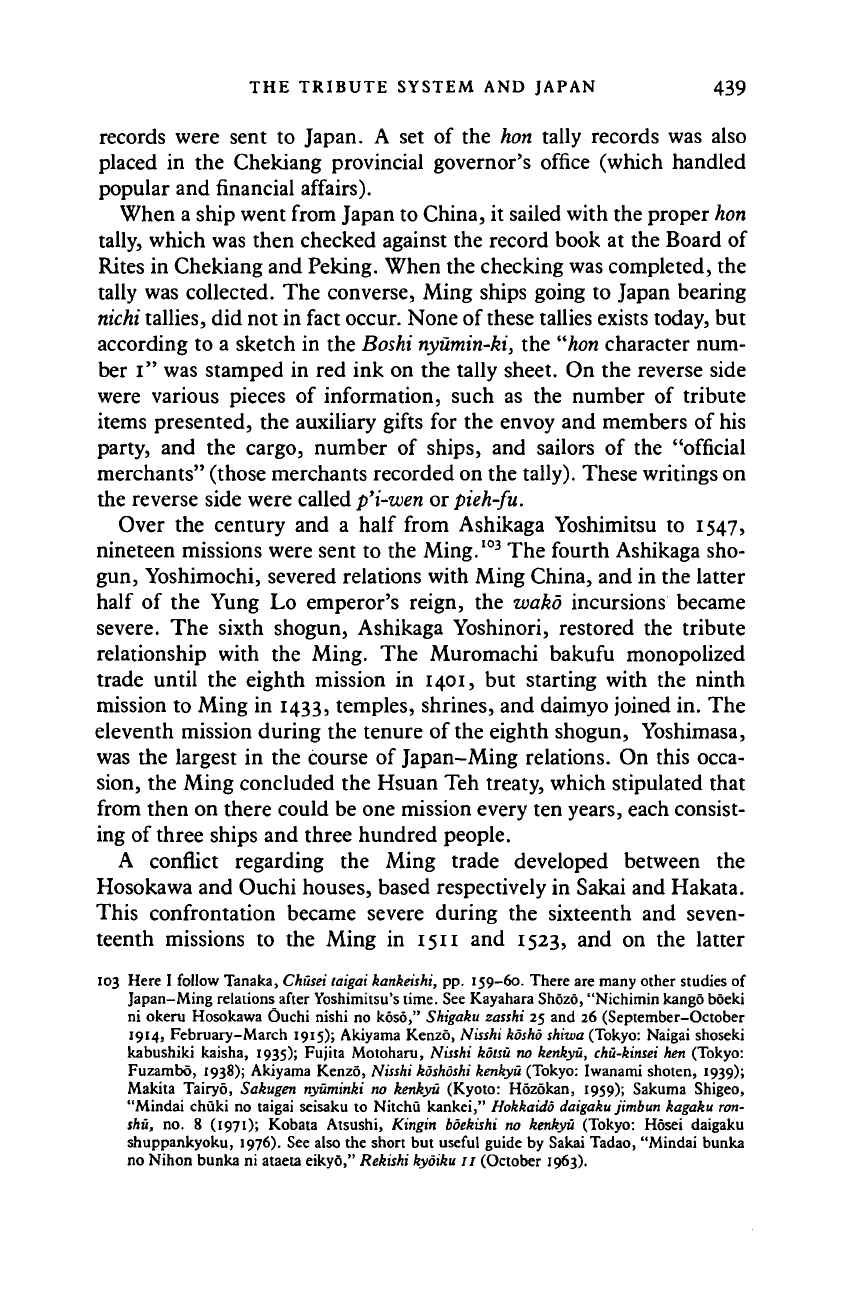
THE TRIBUTE SYSTEM AND JAPAN 439
records were sent to Japan. A set of the hon tally records was also
placed in the Chekiang provincial governor's office (which handled
popular and financial affairs).
When a ship went from Japan to China, it sailed with the proper hon
tally, which was then checked against the record book at the Board of
Rites in Chekiang and Peking. When the checking was completed, the
tally was collected. The converse, Ming ships going to Japan bearing
nichi tallies, did not in fact occur. None of these tallies exists today, but
according to a sketch in the Boshi nyumin-ki, the "hon character num-
ber i" was stamped in red ink on the tally sheet. On the reverse side
were various pieces of information, such as the number of tribute
items presented, the auxiliary gifts for the envoy and members of his
party, and the cargo, number of ships, and sailors of the "official
merchants" (those merchants recorded on the tally). These writings on
the reverse side were called
p'i-wen
or pieh-fu.
Over the century and a half from Ashikaga Yoshimitsu to 1547,
nineteen missions were sent to the Ming.
I03
The fourth Ashikaga sho-
gun, Yoshimochi, severed relations with Ming China, and in the latter
half of the Yung Lo emperor's reign, the wako incursions became
severe. The sixth shogun, Ashikaga Yoshinori, restored the tribute
relationship with the Ming. The Muromachi bakufu monopolized
trade until the eighth mission in 1401, but starting with the ninth
mission to Ming in 1433, temples, shrines, and daimyo joined in. The
eleventh mission during the tenure of the eighth shogun, Yoshimasa,
was the largest in the course of Japan-Ming relations. On this occa-
sion, the Ming concluded the Hsuan Teh treaty, which stipulated that
from then on there could be one mission every ten years, each consist-
ing of three ships and three hundred people.
A conflict regarding the Ming trade developed between the
Hosokawa and Ouchi houses, based respectively in Sakai and Hakata.
This confrontation became severe during the sixteenth and seven-
teenth missions to the Ming in 1511 and 1523, and on the latter
103 Here I follow Tanaka, Chusei laigai
kankeishi,
pp. 159-60. There are many other studies of
Japan-Ming relations after Yoshimitsu's time. See Kayahara Shozo, "Nichimin kango boeki
ni okeru Hosokawa Ouchi nishi no k6so," Shigaku zasshi 25 and 26 (September-October
1914,
February-March 1915); Akiyama Kenzo, Nisshi
kosho
shiwa (Tokyo: Naigai shoseki
kabushiki kaisha, 1935); Fujita Motoharu, Nisshi kdlsu no kenkyu,
chu-kinsei
hen (Tokyo:
Fuzambo, 1938); Akiyama Kenzo, Nisshi
koshoshi
kenkyu (Tokyo: Iwanami shoten, 1939);
Makita Tairyo, Sakugen nyuminki no kenkyu (Kyoto: Hozokan, 1959); Sakuma Shigeo,
"Mindai chuki no taigai seisaku to Nitchu kankei," Hokkaido
daigaku
jimbun kagaku ron-
shu,
no. 8 (1971); Kobata Atsushi, Kingin boekishi no kenkyu (Tokyo: Hosei daigaku
shuppankyoku, 1976). See also the short but useful guide by Sakai Tadao, "Mindai bunka
no Nihon bunka ni ataeta eikyo," Rekishi kyoiku 11 (October 1963).
Cambridge Histories Online © Cambridge University Press, 2008
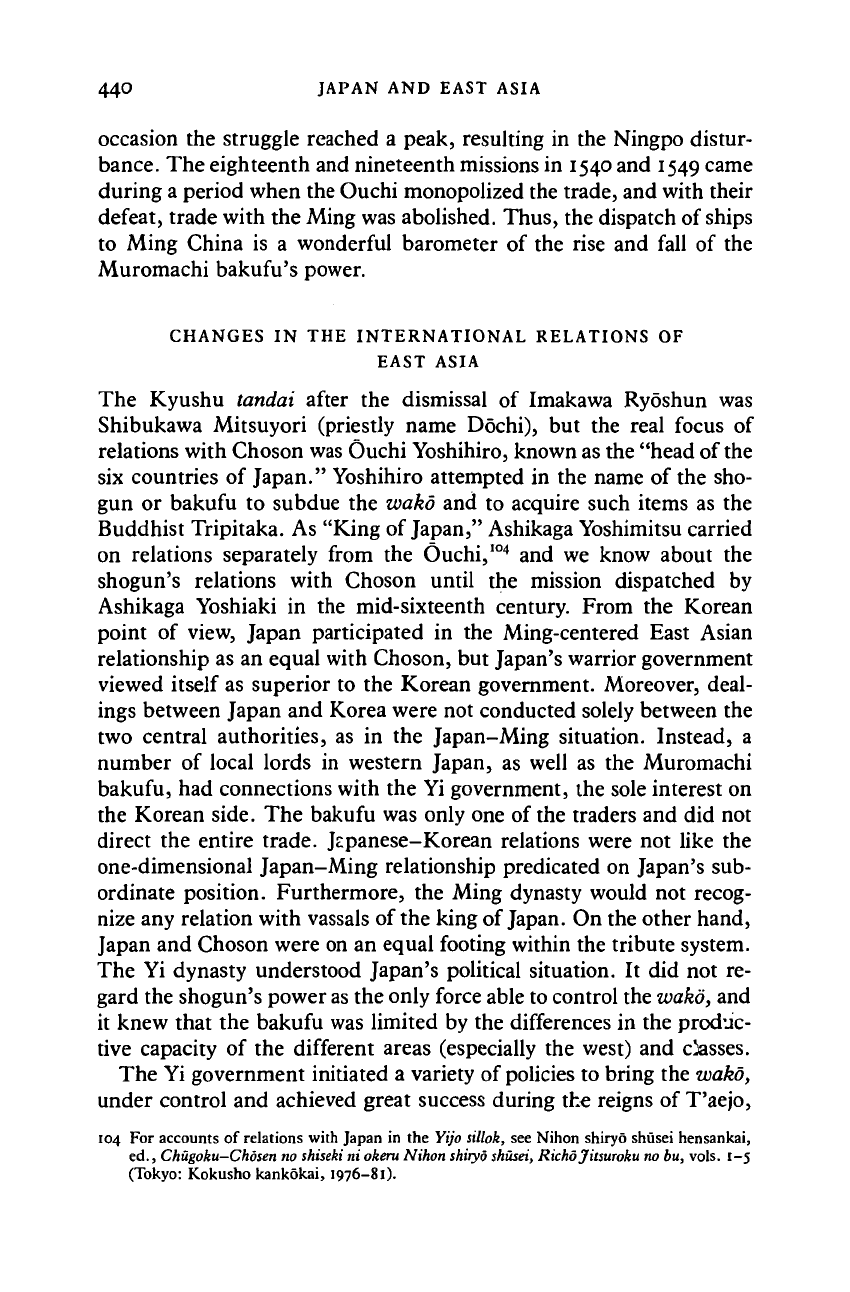
440 JAPAN AND EAST ASIA
occasion the struggle reached a peak, resulting in the Ningpo distur-
bance. The eighteenth and nineteenth missions in 1540 and 1549 came
during a period when the Ouchi monopolized the trade, and with their
defeat, trade with the Ming was abolished. Thus, the dispatch of ships
to Ming China is a wonderful barometer of the rise and fall of the
Muromachi bakufu's power.
CHANGES IN THE INTERNATIONAL RELATIONS OF
EAST ASIA
The Kyushu tandai after the dismissal of Imakawa Ryoshun was
Shibukawa Mitsuyori (priestly name Dochi), but the real focus of
relations with Choson was Ouchi Yoshihiro, known as the "head of the
six countries of Japan." Yoshihiro attempted in the name of the sho-
gun or bakufu to subdue the wako and to acquire such items as the
Buddhist Tripitaka. As "King of Japan," Ashikaga Yoshimitsu carried
on relations separately from the Ouchi,
104
and we know about the
shogun's relations with Choson until the mission dispatched by
Ashikaga Yoshiaki in the mid-sixteenth century. From the Korean
point of view, Japan participated in the Ming-centered East Asian
relationship as an equal with Choson, but Japan's warrior government
viewed itself as superior to the Korean government. Moreover, deal-
ings between Japan and Korea were not conducted solely between the
two central authorities, as in the Japan-Ming situation. Instead, a
number of local lords in western Japan, as well as the Muromachi
bakufu, had connections with the Yi government, the sole interest on
the Korean side. The bakufu was only one of the traders and did not
direct the entire trade. Jepanese-Korean relations were not like the
one-dimensional Japan-Ming relationship predicated on Japan's sub-
ordinate position. Furthermore, the Ming dynasty would not recog-
nize any relation with vassals of the king of
Japan.
On the other hand,
Japan and Choson were on an equal footing within the tribute system.
The Yi dynasty understood Japan's political situation. It did not re-
gard the shogun's power
as
the only force able to control the
wako,
and
it knew that the bakufu was limited by the differences in the produc-
tive capacity of the different areas (especially the west) and ciasses.
The Yi government initiated a variety of policies to bring the wako,
under control and achieved great success during the reigns of T'aejo,
104 For accounts of relations with Japan in the Yijo sillok, see Nihon shiryd shusei hensankai,
ed., Chugoku-Chosen no shiseki ni okeru Nihon
shiryd
shusei, Richojitsuroku no bu, vols. 1-5
(Tokyo: Kokusho kankokai, 1976-81).
Cambridge Histories Online © Cambridge University Press, 2008
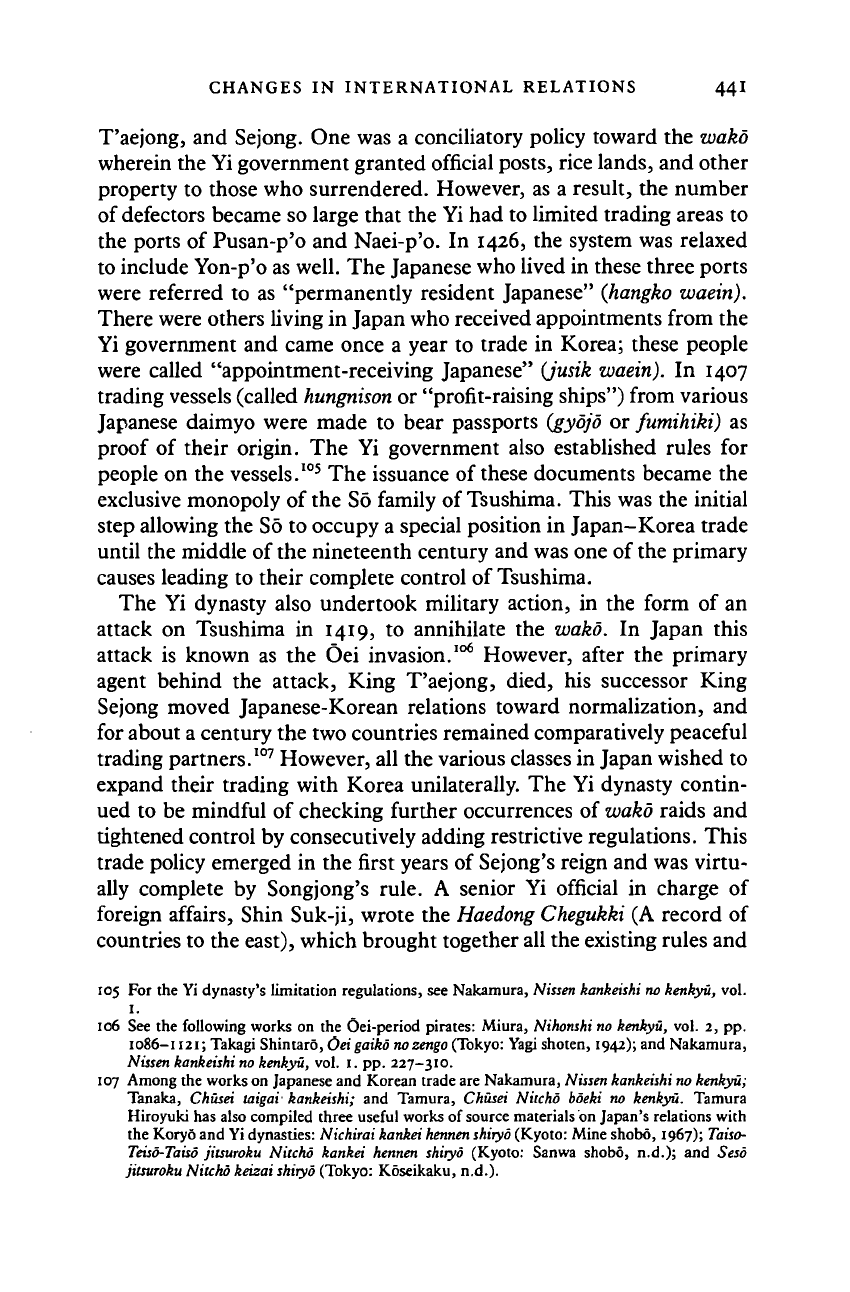
CHANGES IN INTERNATIONAL RELATIONS 44I
T'aejong, and Sejong. One was a conciliatory policy toward the wako
wherein the Yi government granted official posts, rice lands, and other
property to those who surrendered. However, as a result, the number
of defectors became so large that the Yi had to limited trading areas to
the ports of Pusan-p'o and Naei-p'o. In 1426, the system was relaxed
to include Yon-p'o as well. The Japanese who lived in these three ports
were referred to as "permanently resident Japanese" (hangko waein).
There were others living in Japan who received appointments from the
Yi government and came once a year to trade in Korea; these people
were called "appointment-receiving Japanese" (jusik waein). In 1407
trading vessels (called
hungnison
or "profit-raising ships") from various
Japanese daimyo were made to bear passports (gyqjo or fumihiki) as
proof of their origin. The Yi government also established rules for
people on the vessels.
105
The issuance of these documents became the
exclusive monopoly of the So family of Tsushima. This was the initial
step allowing the So to occupy a special position in Japan-Korea trade
until the middle of the nineteenth century and was one of the primary
causes leading to their complete control of Tsushima.
The Yi dynasty also undertook military action, in the form of an
attack on Tsushima in 1419, to annihilate the wako. In Japan this
attack is known as the Oei invasion.
106
However, after the primary
agent behind the attack, King T'aejong, died, his successor King
Sejong moved Japanese-Korean relations toward normalization, and
for about a century the two countries remained comparatively peaceful
trading partners.
107
However, all the various classes in Japan wished to
expand their trading with Korea unilaterally. The Yi dynasty contin-
ued to be mindful of checking further occurrences of wako raids and
tightened control by consecutively adding restrictive regulations. This
trade policy emerged in the first years of Sejong's reign and was virtu-
ally complete by Songjong's rule. A senior Yi official in charge of
foreign affairs, Shin Suk-ji, wrote the Haedong Chegukki (A record of
countries to the east), which brought together all the existing rules and
105 For the Yi dynasty's limitation regulations, see Nakamura, Nissen kankeishi no kenkyu, vol.
1.
106 See the following works on the Oei-period pirates: Miura, Nihonshi no ketikyii, vol. 2, pp.
1086-1121;
Takagi Shintaro, Oei gaiko
no zengo
(Tokyo: Yagi shoten, 1942); and Nakamura,
Nissen kankeishi no kenkyu, vol. 1. pp. 227-310.
107 Among the works on Japanese and Korean trade are Nakamura, Nissen kankeishi no kenkyu;
Tanaka, Chusei taigai kankeishi; and Tamura, Chiisei Nitcho boeki no kenkyu. Tamura
Hiroyuki has also compiled three useful works of source materials on Japan's relations with
the Koryo and Yi dynasties: Nichirai kankei
hennen shiryo
(Kyoto: Mine shobo, 1967); Taiso-
Teiso-Taiso
jitsuroku Nitcho kankei hennen shiryo (Kyoto: Sanwa shobo, n.d.); and Seso
jilsuroku Nitcho keizai shiryo (Tokyo: Koseikaku, n.d.).
Cambridge Histories Online © Cambridge University Press, 2008
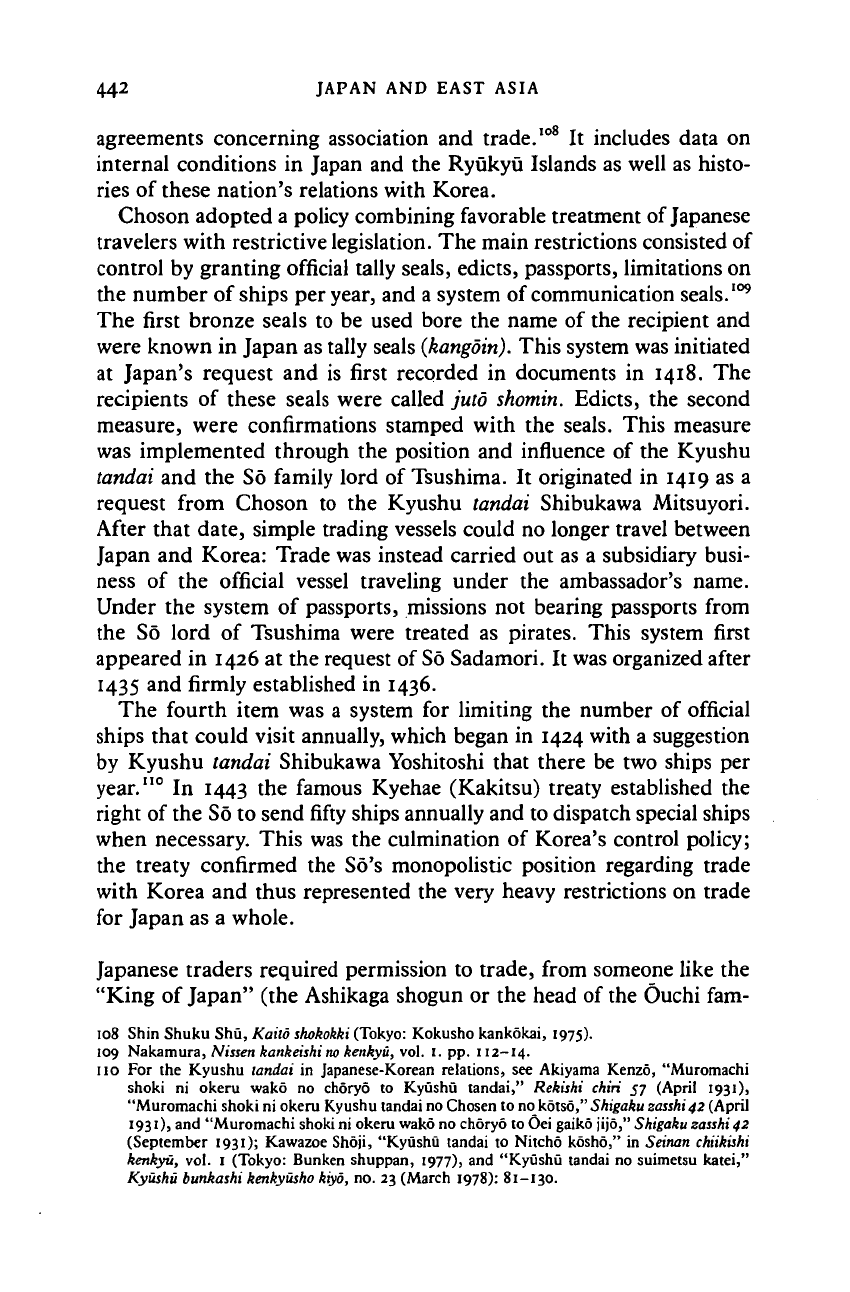
442 JAPAN AND EAST ASIA
agreements concerning association and trade.
108
It includes data on
internal conditions in Japan and the Ryukyu Islands as well as histo-
ries of these nation's relations with Korea.
Choson adopted a policy combining favorable treatment of Japanese
travelers with restrictive legislation. The main restrictions consisted of
control by granting official tally seals, edicts, passports, limitations on
the number of ships per year, and a system of communication seals.
109
The first bronze seals to be used bore the name of the recipient and
were known in Japan as tally seals
(kangoin).
This system was initiated
at Japan's request and is first recorded in documents in 1418. The
recipients of these seals were called juto
shotnin.
Edicts, the second
measure, were confirmations stamped with the seals. This measure
was implemented through the position and influence of the Kyushu
tandai
and the So family lord of Tsushima. It originated in 1419 as a
request from Choson to the Kyushu tandai Shibukawa Mitsuyori.
After that date, simple trading vessels could no longer travel between
Japan and Korea: Trade was instead carried out as a subsidiary busi-
ness of the official vessel traveling under the ambassador's name.
Under the system of passports, missions not bearing passports from
the So lord of Tsushima were treated as pirates. This system first
appeared in 1426 at the request of
So
Sadamori. It was organized after
1435 and firmly established in 1436.
The fourth item was a system for limiting the number of official
ships that could visit annually, which began in 1424 with a suggestion
by Kyushu tandai Shibukawa Yoshitoshi that there be two ships per
year.
110
In 1443 the famous Kyehae (Kakitsu) treaty established the
right of the So to send
fifty
ships annually and to dispatch special ships
when necessary. This was the culmination of Korea's control policy;
the treaty confirmed the So's monopolistic position regarding trade
with Korea and thus represented the very heavy restrictions on trade
for Japan as a whole.
Japanese traders required permission to trade, from someone like the
"King of Japan" (the Ashikaga shogun or the head of the Ouchi fam-
108 Shin Shuku Shu, Kaito
shokokki
(Tokyo: Kokusho kankokai, 1975).
109 Nakamura, Nissen kankeishi
no
kenkyu, vol. 1. pp. 112-14.
no For the Kyushu tandai in Japanese-Korean relations, see Akiyama Kenzo, "Muromachi
shoki ni okeru wako no choryo to Kyushu tandai," Rekishi chiri 57 (April 1931),
"Muromachi shoki ni okeru Kyushu tandai no Chosen to no
kotso,"
Shigaku zasshi
42 (April
1931),
and "Muromachi shoki ni okeru wako no choryo to Oei gaiko jijo,"
Shigaku zasshi
42
(September 1931); Kawazoe Shoji, "Kyushu tandai to Nitcho kosho," in Seinan chiikishi
kenkyu, vol. 1 (Tokyo: Bunken shuppan, 1977), and "Kyushu tandai no suimetsu katei,"
Kyushu bunkashi
kenkyusho
kiyo,
no. 23 (March 1978): 81-130.
Cambridge Histories Online © Cambridge University Press, 2008
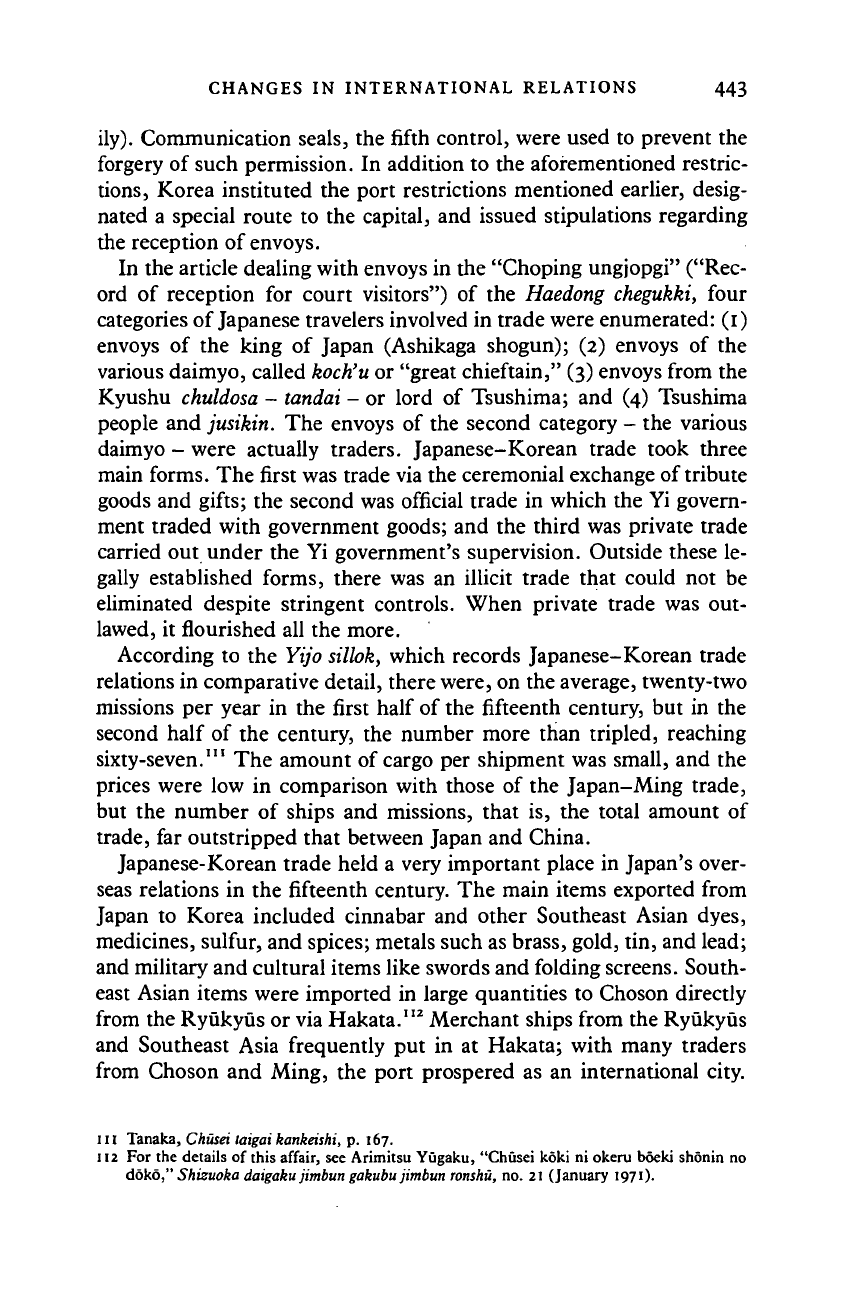
CHANGES IN INTERNATIONAL RELATIONS 443
ily).
Communication seals, the fifth control, were used to prevent the
forgery of such permission. In addition to the aforementioned restric-
tions,
Korea instituted the port restrictions mentioned earlier, desig-
nated a special route to the capital, and issued stipulations regarding
the reception of envoys.
In the article dealing with envoys in the "Choping ungjopgi" ("Rec-
ord of reception for court visitors") of the
Haedong
chegukki,
four
categories of Japanese travelers involved in trade were enumerated: (i)
envoys of the king of Japan (Ashikaga shogun); (2) envoys of the
various daimyo, called
koch'u
or "great chieftain," (3) envoys from the
Kyushu
chuldosa
-
tandai
- or lord of Tsushima; and (4) Tsushima
people and jusikin. The envoys of the second category - the various
daimyo - were actually traders. Japanese-Korean trade took three
main forms. The first was trade via the ceremonial exchange of tribute
goods and gifts; the second was official trade in which the Yi govern-
ment traded with government goods; and the third was private trade
carried out under the Yi government's supervision. Outside these le-
gally established forms, there was an illicit trade that could not be
eliminated despite stringent controls. When private trade was out-
lawed, it flourished all the more.
According to the Yijo
sillok,
which records Japanese-Korean trade
relations in comparative detail, there
were,
on the average, twenty-two
missions per year in the first half of the fifteenth century, but in the
second half of the century, the number more than tripled, reaching
sixty-seven."
1
The amount of cargo per shipment was small, and the
prices were low in comparison with those of the Japan-Ming trade,
but the number of ships and missions, that is, the total amount of
trade, far outstripped that between Japan and China.
Japanese-Korean trade held a very important place in Japan's over-
seas relations in the fifteenth century. The main items exported from
Japan to Korea included cinnabar and other Southeast Asian dyes,
medicines, sulfur, and spices; metals such as brass, gold, tin, and lead;
and military and cultural items like swords and folding
screens.
South-
east Asian items were imported in large quantities to Choson directly
from the Ryukyus or via Hakata."
2
Merchant ships from the Ryukyus
and Southeast Asia frequently put in at Hakata; with many traders
from Choson and Ming, the port prospered as an international city.
111 Tanaka, Chusei taigai kankeishi, p. 167.
112 For the details of this affair, see Arimitsu Yugaku, "Chusei koki ni okeru boeki shonin no
doko,"
Shizuoka daigaku jimbun gakubu jimbun ronshu, no. 21 (January 1971).
Cambridge Histories Online © Cambridge University Press, 2008
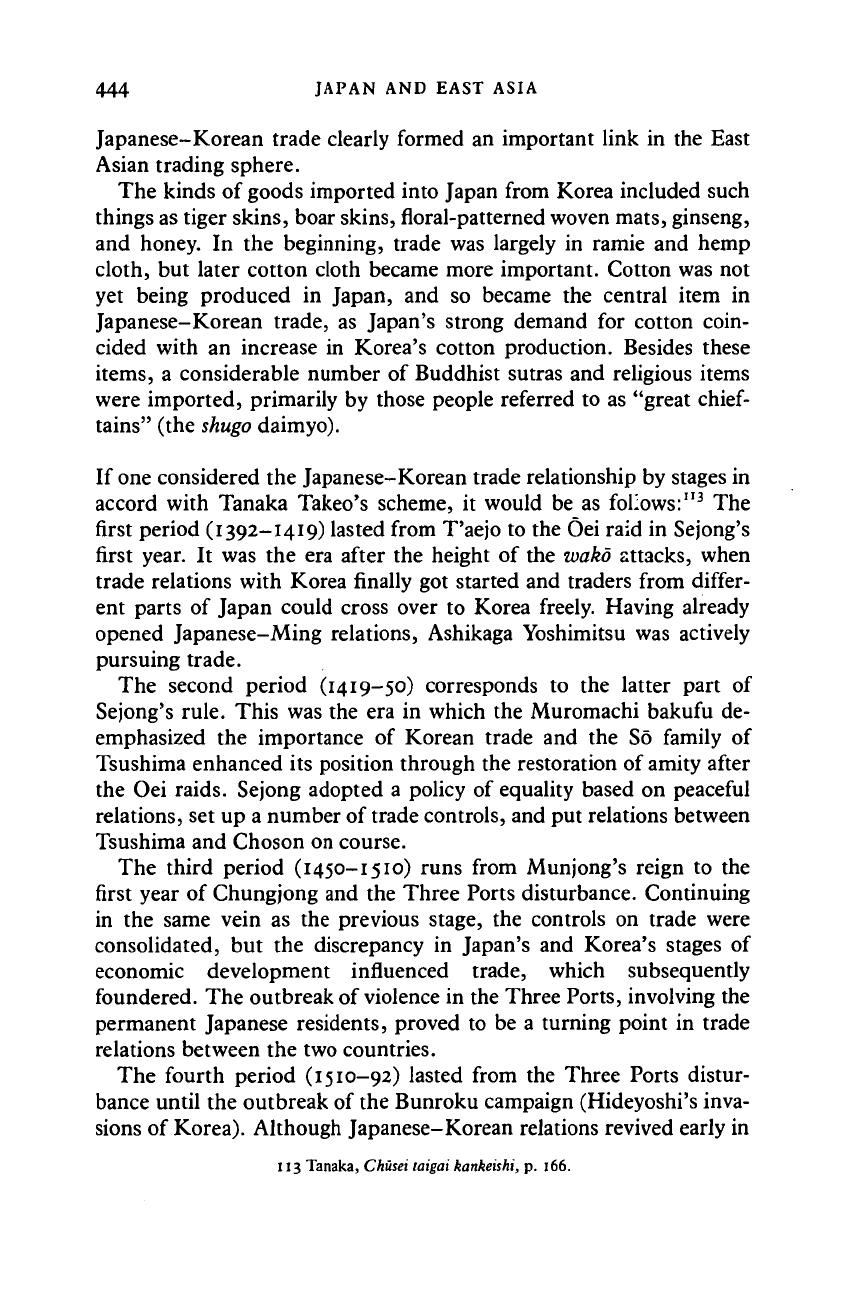
444 JAPAN AND EAST ASIA
Japanese-Korean trade clearly formed an important link in the East
Asian trading sphere.
The kinds of goods imported into Japan from Korea included such
things as tiger skins, boar skins,
floral-patterned
woven mats, ginseng,
and honey. In the beginning, trade was largely in ramie and hemp
cloth, but later cotton cloth became more important. Cotton was not
yet being produced in Japan, and so became the central item in
Japanese-Korean trade, as Japan's strong demand for cotton coin-
cided with an increase in Korea's cotton production. Besides these
items,
a considerable number of Buddhist sutras and religious items
were imported, primarily by those people referred to as "great
chief-
tains"
(the
shugo
daimyo).
If one considered the Japanese-Korean trade relationship by stages in
accord with Tanaka Takeo's scheme, it would be as follows:"
3
The
first period (1392-1419) lasted from T'aejo to the Oei raid in Sejong's
first year. It was the era after the height of the wako attacks, when
trade relations with Korea finally got started and traders from differ-
ent parts of Japan could cross over to Korea freely. Having already
opened Japanese-Ming relations, Ashikaga Yoshimitsu was actively
pursuing trade.
The second period (1419-50) corresponds to the latter part of
Sejong's rule. This was the era in which the Muromachi bakufu de-
emphasized the importance of Korean trade and the So family of
Tsushima enhanced its position through the restoration of amity after
the Oei raids. Sejong adopted a policy of equality based on peaceful
relations, set up a number of trade controls, and put relations between
Tsushima and Choson on course.
The third period (1450-1510) runs from Munjong's reign to the
first year of Chungjong and the Three Ports disturbance. Continuing
in the same vein as the previous stage, the controls on trade were
consolidated, but the discrepancy in Japan's and Korea's stages of
economic development influenced trade, which subsequently
foundered. The outbreak of violence in the Three Ports, involving the
permanent Japanese residents, proved to be a turning point in trade
relations between the two countries.
The fourth period (1510-92) lasted from the Three Ports distur-
bance until the outbreak of the Bunroku campaign (Hideyoshi's inva-
sions of Korea). Although Japanese-Korean relations revived early in
113 Tanaka, Chusei laigai
kankeishi,
p. 166.
Cambridge Histories Online © Cambridge University Press, 2008
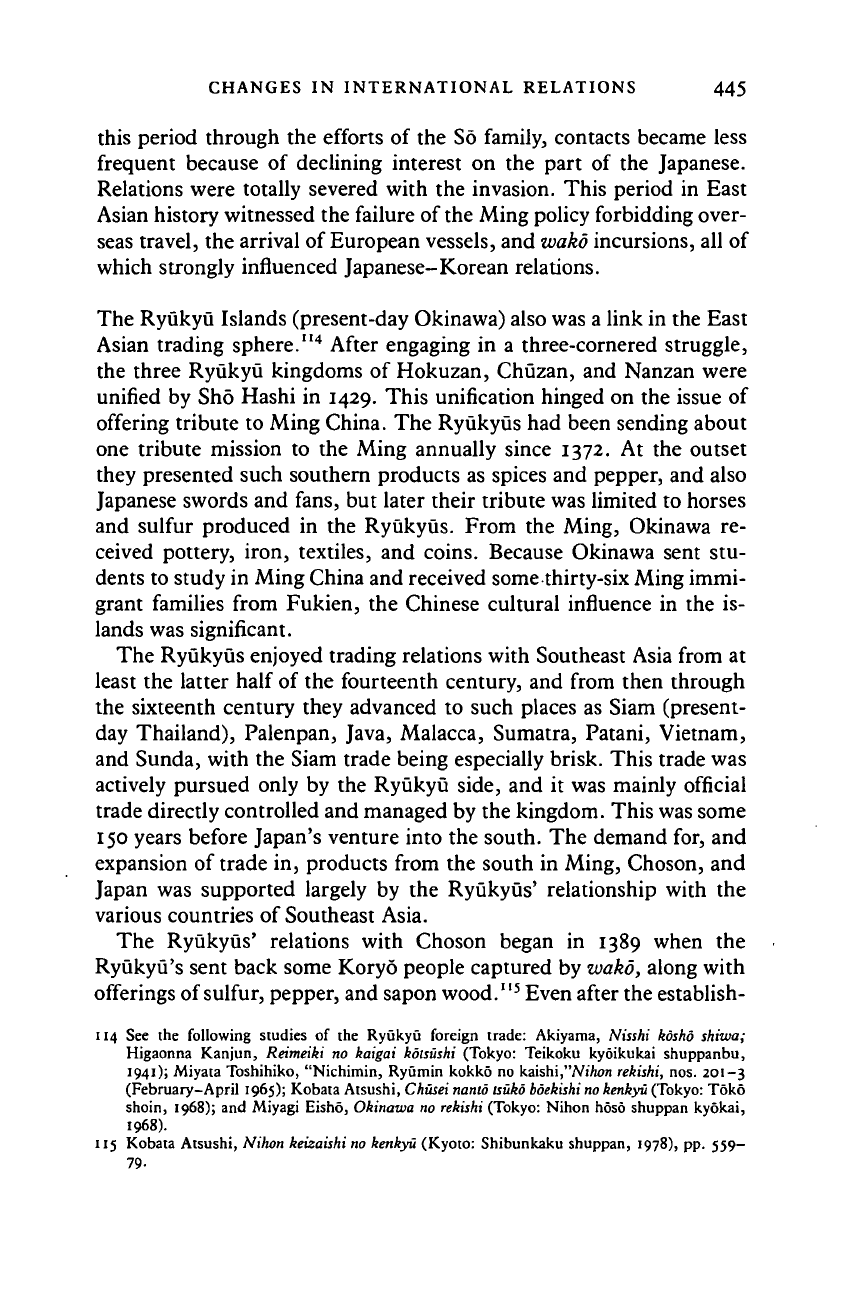
CHANGES IN INTERNATIONAL RELATIONS 445
this period through the efforts of the So family, contacts became less
frequent because of declining interest on the part of the Japanese.
Relations were totally severed with the invasion. This period in East
Asian history witnessed the failure of the Ming policy forbidding over-
seas travel, the arrival of European vessels, and wako incursions, all of
which strongly influenced Japanese-Korean relations.
The Ryukyu Islands (present-day Okinawa) also was a link in the East
Asian trading sphere."
4
After engaging in a three-cornered struggle,
the three Ryukyu kingdoms of Hokuzan, Chuzan, and Nanzan were
unified by Sho Hashi in 1429. This unification hinged on the issue of
offering tribute to Ming China. The Ryukyus had been sending about
one tribute mission to the Ming annually since 1372. At the outset
they presented such southern products as spices and pepper, and also
Japanese swords and fans, but later their tribute was limited to horses
and sulfur produced in the Ryukyus. From the Ming, Okinawa re-
ceived pottery, iron, textiles, and coins. Because Okinawa sent stu-
dents to study in Ming China and received some thirty-six Ming immi-
grant families from Fukien, the Chinese cultural influence in the is-
lands was significant.
The Ryukyus enjoyed trading relations with Southeast Asia from at
least the latter half of the fourteenth century, and from then through
the sixteenth century they advanced to such places as Siam (present-
day Thailand), Palenpan, Java, Malacca, Sumatra, Patani, Vietnam,
and Sunda, with the Siam trade being especially brisk. This trade was
actively pursued only by the Ryukyu side, and it was mainly official
trade directly controlled and managed by the kingdom. This was some
150 years before Japan's venture into the south. The demand for, and
expansion of trade in, products from the south in Ming, Choson, and
Japan was supported largely by the Ryukyus' relationship with the
various countries of Southeast Asia.
The Ryukyus' relations with Choson began in 1389 when the
Ryukyu's sent back some Koryo people captured by wako, along with
offerings of sulfur, pepper, and sapon wood."
5
Even after the establish-
114 See the following studies of the Ryukyu foreign trade: Akiyama, Nisshi kosho shiwa;
Higaonna Kanjun, Reimeiki no kaigai kouushi (Tokyo: Teikoku kyoikukai shuppanbu,
1941);
Miyata Toshihiko, "Nichimin, Ryumin kokko no kaishi,'WiAon rekishi, nos. 201—3
(February-April 1965); Kobata Atsushi, Chusei nanto tsuko
boekishi no
kenkyu (Tokyo: Toko
shoin, 1968); and Miyagi Eisho, Okinawa no rekishi (Tokyo: Nihon hoso shuppan kyokai,
1968).
115 Kobata Atsushi, Nihon keizaishi no kenkyu (Kyoto: Shibunkaku shuppan, 1978), pp. 559-
79-
Cambridge Histories Online © Cambridge University Press, 2008
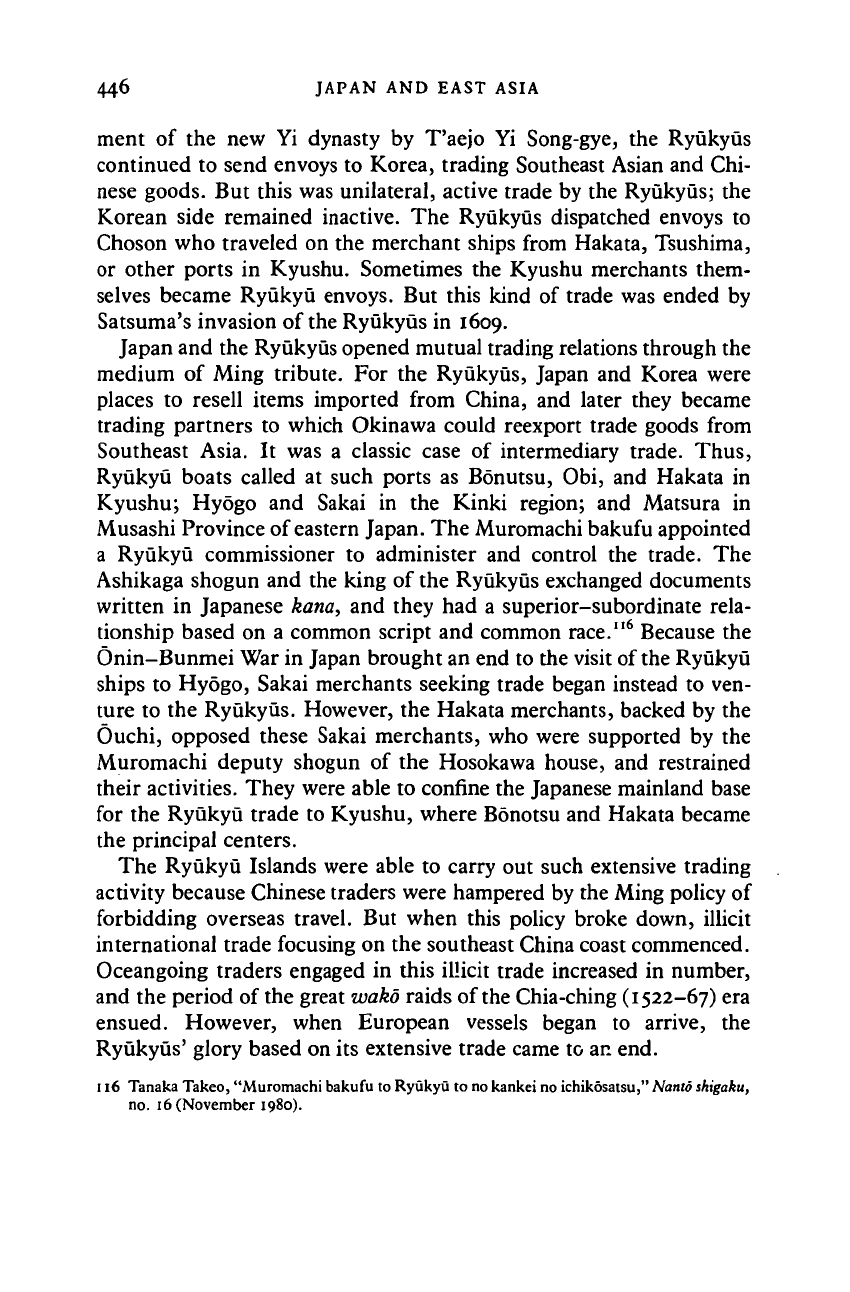
446 JAPAN AND EAST ASIA
ment of the new Yi dynasty by T'aejo Yi Song-gye, the Ryukyus
continued to send envoys to Korea, trading Southeast Asian and Chi-
nese goods. But this was unilateral, active trade by the Ryukyus; the
Korean side remained inactive. The Ryukyus dispatched envoys to
Choson who traveled on the merchant ships from Hakata, Tsushima,
or other ports in Kyushu. Sometimes the Kyushu merchants them-
selves became Ryukyu envoys. But this kind of trade was ended by
Satsuma's invasion of the Ryukyus in 1609.
Japan and the Ryukyus opened mutual trading relations through the
medium of Ming tribute. For the Ryukyus, Japan and Korea were
places to resell items imported from China, and later they became
trading partners to which Okinawa could reexport trade goods from
Southeast Asia. It was a classic case of intermediary trade. Thus,
Ryukyu boats called at such ports as Bonutsu, Obi, and Hakata in
Kyushu; Hyogo and Sakai in the Kinki region; and Matsura in
Musashi Province of eastern Japan. The Muromachi bakufu appointed
a Ryukyu commissioner to administer and control the trade. The
Ashikaga shogun and the king of the Ryukyus exchanged documents
written in Japanese kana, and they had a superior-subordinate rela-
tionship based on a common script and common race.
1
'
6
Because the
Onin-Bunmei War in Japan brought an end to the visit of
the
Ryukyu
ships to Hyogo, Sakai merchants seeking trade began instead to ven-
ture to the Ryukyus. However, the Hakata merchants, backed by the
Ouchi, opposed these Sakai merchants, who were supported by the
Muromachi deputy shogun of the Hosokawa house, and restrained
their activities. They were able to confine the Japanese mainland base
for the Ryukyu trade to Kyushu, where Bonotsu and Hakata became
the principal centers.
The Ryukyu Islands were able to carry out such extensive trading
activity because Chinese traders were hampered by the Ming policy of
forbidding overseas travel. But when this policy broke down, illicit
international trade focusing on the southeast China coast commenced.
Oceangoing traders engaged in this illicit trade increased in number,
and the period of the great wako raids of
the
Chia-ching (1522-67) era
ensued. However, when European vessels began to arrive, the
Ryukyus' glory based on its extensive trade came to an end.
116 Tanaka Takeo, "Muromachi bakufu to Ryukyu to no kankei no ichikosatsu," Nanto
shigaku,
no.
16 (November 1980).
Cambridge Histories Online © Cambridge University Press, 2008
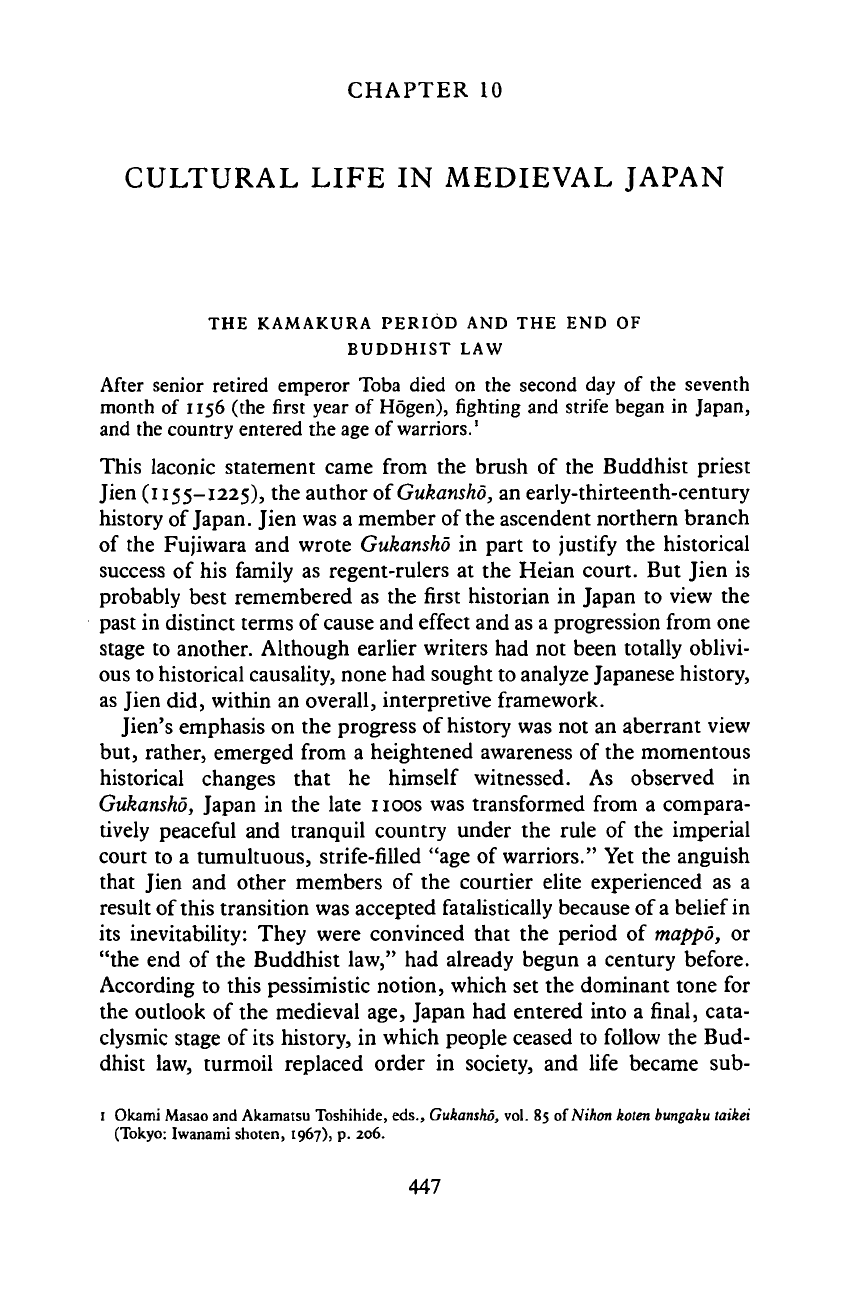
CHAPTER 10
CULTURAL LIFE IN MEDIEVAL JAPAN
THE KAMAKURA PERIOD AND THE END OF
BUDDHIST LAW
After senior retired emperor Toba died on the second day of the seventh
month of 1156 (the first year of Hogen), fighting and strife began in Japan,
and the country entered the age of warriors.
1
This laconic statement came from the brush of the Buddhist priest
Jien (1155-1225), the author oiGukansho, an early-thirteenth-century
history of Japan. Jien was a member of the ascendent northern branch
of the Fujiwara and wrote Gukansho in part to justify the historical
success of his family as regent-rulers at the Heian court. But Jien is
probably best remembered as the first historian in Japan to view the
past in distinct terms of cause and effect and as a progression from one
stage to another. Although earlier writers had not been totally oblivi-
ous to historical causality, none had sought to analyze Japanese history,
as Jien did, within an overall, interpretive framework.
Jien's emphasis on the progress of history was not an aberrant view
but, rather, emerged from a heightened awareness of the momentous
historical changes that he himself witnessed. As observed in
Gukansho, Japan in the late 1100s was transformed from a compara-
tively peaceful and tranquil country under the rule of the imperial
court to a tumultuous, strife-filled "age of warriors." Yet the anguish
that Jien and other members of the courtier elite experienced as a
result of this transition was accepted fatalistically because of
a
belief in
its inevitability: They were convinced that the period of
mappd,
or
"the end of the Buddhist law," had already begun a century before.
According to this pessimistic notion, which set the dominant tone for
the outlook of the medieval age, Japan had entered into a final, cata-
clysmic stage of its history, in which people ceased to follow the Bud-
dhist law, turmoil replaced order in society, and life became sub-
1 Okami Masao and Akamatsu Toshihide, eds., Gukansho, vol. 85 of Nihon koten bungaku taikei
(Tokyo: Iwanami shoten, 1967), p. 206.
447
Cambridge Histories Online © Cambridge University Press, 2008
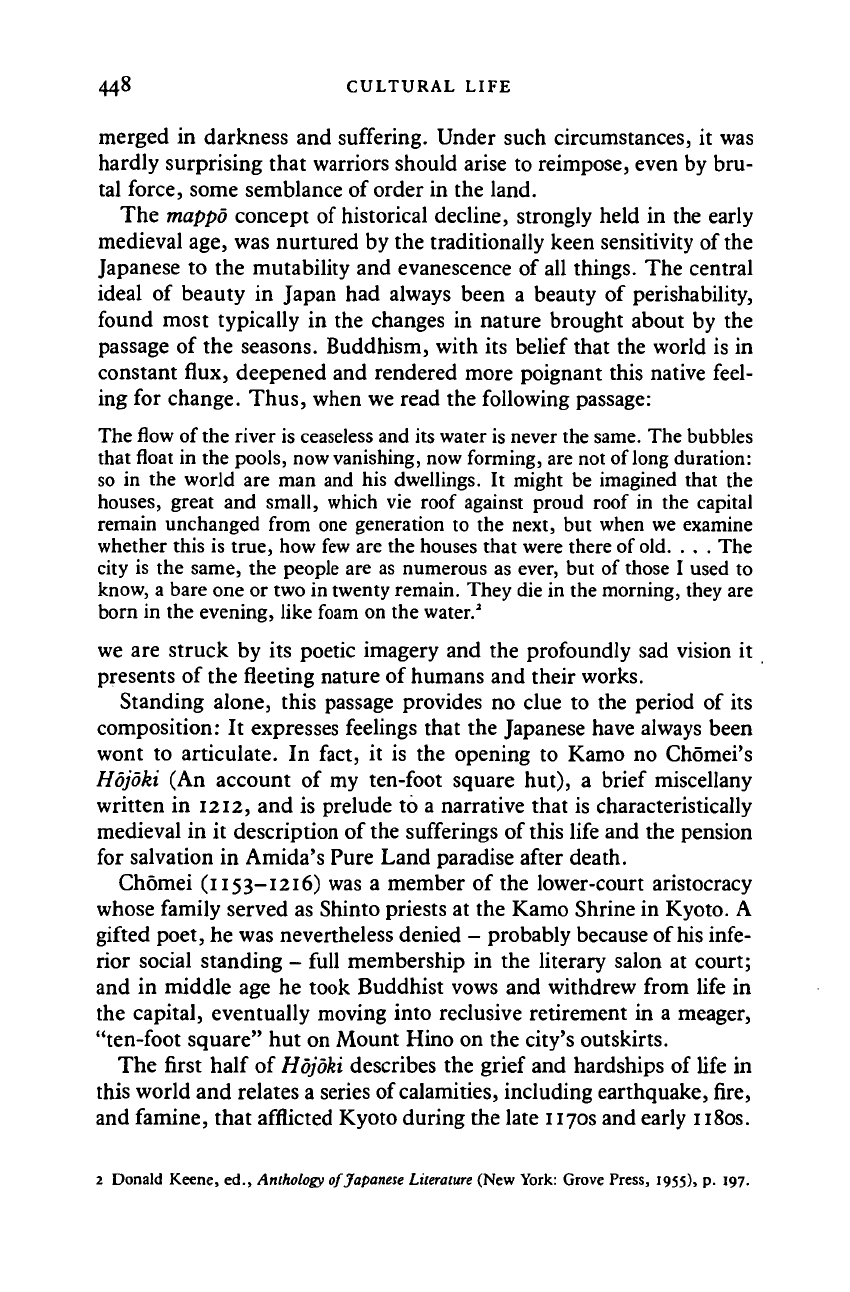
448 CULTURAL LIFE
merged in darkness and suffering. Under such circumstances, it was
hardly surprising that warriors should arise to reimpose, even by bru-
tal force, some semblance of order in the land.
The mappo concept of historical decline, strongly held in the early
medieval age, was nurtured by the traditionally keen sensitivity of the
Japanese to the mutability and evanescence of all things. The central
ideal of beauty in Japan had always been a beauty of perishability,
found most typically in the changes in nature brought about by the
passage of the seasons. Buddhism, with its belief that the world is in
constant flux, deepened and rendered more poignant this native feel-
ing for change. Thus, when we read the following passage:
The flow of the river is ceaseless and its water is never the same. The bubbles
that float in the pools, now vanishing, now forming, are not of
long
duration:
so in the world are man and his dwellings. It might be imagined that the
houses, great and small, which vie roof against proud roof in the capital
remain unchanged from one generation to the next, but when we examine
whether this is true, how few are the houses that were there of
old.
. . . The
city is the same, the people are as numerous as ever, but of those I used to
know, a bare one or two in twenty remain. They die in the morning, they are
born in the evening, like foam on the water.
2
we are struck by its poetic imagery and the profoundly sad vision it
presents of the fleeting nature of humans and their works.
Standing alone, this passage provides no clue to the period of its
composition: It expresses feelings that the Japanese have always been
wont to articulate. In fact, it is the opening to Kamo no Chomei's
Hojoki (An account of my ten-foot square hut), a brief miscellany
written in 1212, and is prelude to a narrative that is characteristically
medieval in it description of the sufferings of this life and the pension
for salvation in Amida's Pure Land paradise after death.
Chomei (115 3-1216) was a member of the lower-court aristocracy
whose family served as Shinto priests at the Kamo Shrine in Kyoto. A
gifted poet, he was nevertheless denied - probably because of his infe-
rior social standing - full membership in the literary salon at court;
and in middle age he took Buddhist vows and withdrew from life in
the capital, eventually moving into reclusive retirement in a meager,
"ten-foot square" hut on Mount Hino on the city's outskirts.
The first half of Hojoki describes the grief and hardships of life in
this world and relates a series of calamities, including earthquake, fire,
and famine, that afflicted Kyoto during the late 1170s and early 1180s.
2 Donald Keene, ed., Anthology of Japanese
Literature
(New York: Grove Press, 1955), p. 197.
Cambridge Histories Online © Cambridge University Press, 2008
